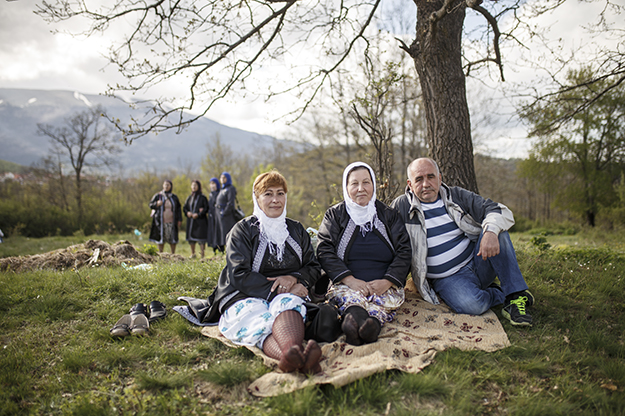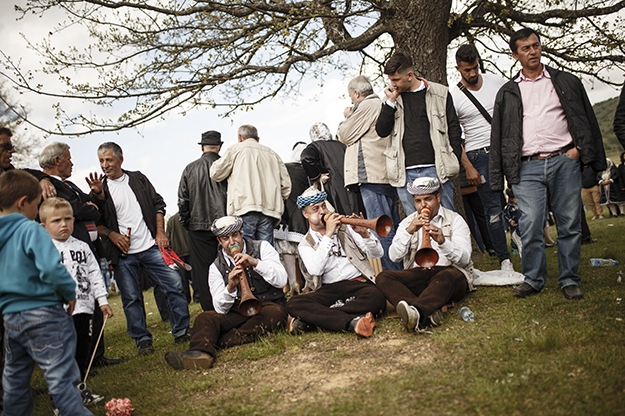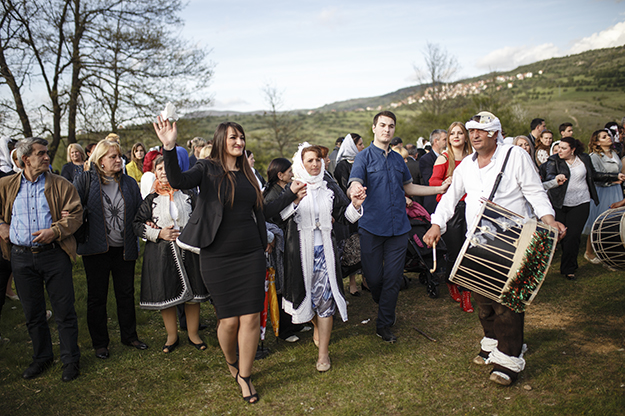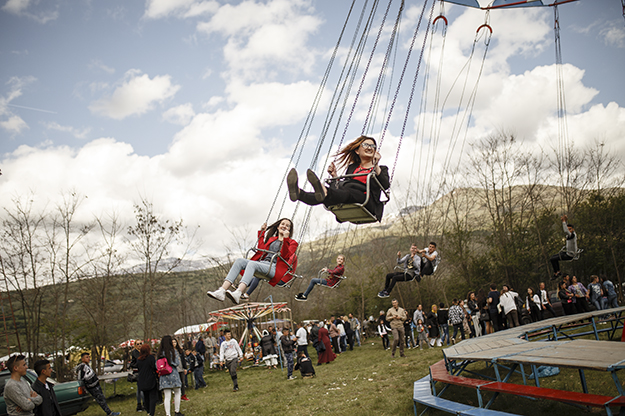Pendija and Zumret Ahmeti never miss being in Dragash each year on May 6. Sitting on a colorful cloth under the branches of a tree newly in leaf, the spot they’ve picked ensures the whole atmosphere of the annual Gorani Day festivities plays out in front of them: The ‘Vlaska’ clearing near the village of Vraniste in the foothills of the Sharri Mountains is overcrowded with thousands of people celebrating.
Although somewhere in distant history the celebrations were originally held to mark Saint George’s Day and the transition of winter to summer, in modern times for most Gorani people the day has somehow lost its religious connotations. Today, it is officially recognized by the Republic of Kosovo as the Day of the Gorani.

Pendija (center) and Zumret Ahmeti (right), pictured with their relative Abdi Dulsija, come back to Dragash from Belgrade each year to celebrate Gorani Day. Photo: Jonas Kako.
“This tradition of gathering here has happened for many centuries,” Zumret says. “All the Gorani come here every year. It is a tradition that has not gone away and never will. More than the Djurdjevdan [St George’s Day] it is a celebration of Gorani people, a possibility for us to meet and see each other.”
The small mountain road that cuts its way through the middle of the celebrations and winds on up and around the mountain is lined by people on both sides, as a constant procession of others walk slowly up and down, greeting familiar faces along the way.
May 6 is also a profitable day for business: Gorani, Albanian and almost all of Kosovo’s ethnicities are represented through different tradespeople located along the field, selling food and drinks, materials for women’s clothes, children’s toys and turns on the fairground rides brought in for the occasion.

The sounds of traditional ‘kaval’ can be heard around the hillside celebrations. Photo: Jonas Kako.
In the middle of the field, to the sounds of tupans (drums) and kaval (wind instruments), people dance the traditional steps of the two-beat kolo (‘circle’) dance as many others stand looking on. Around the periphery families sit eating their own small picnics, while others wander around, catching up with family and friends.

Women and men dance the two-beat ‘kolo,’ accompanied by ‘tupans.’ Photo: Jonas Kako.
“Look over there, that young woman probably just got engaged,” 57-year-old Pendija says, pointing out towards a woman dancing the kolo; the young woman, seemingly in her 20s, is dressed in traditional embroidered white Gorani dress, with a hat full of liras (old gold coins) contrasted with a small flower behind the ear. According to Gorani tradition, young unmarried or engaged women would wear the white jelek (waistcoat) to be distinguished from the black embroidered jelek worn by married women.
“Look at this, it is all hand-made,” Pendija says as she proudly shows her black jelek. “But now I carry just a simple scarf. I am not young anymore to wear those colorful ones.”
Although they have been living in Belgrade for the last four decades, being Gorani and originally from Kosovo’s Gora (Highlands) region in the far south of the country, is very important to the couple’s identity.


